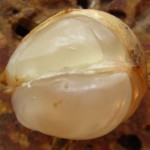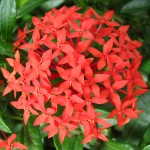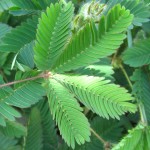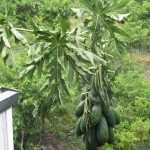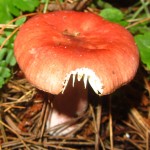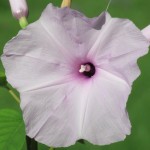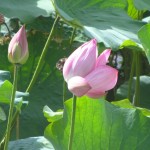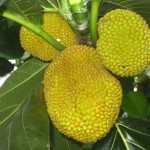Flora and Fauna of Tropical Asia
The fascinating world of tropical nature
Introducing Langsat
The tropical world is home to an incredible variety of unusual and tasty fruits, many of which are completely unknown outside of their natural location. One of them is langsat (Lansium domesticum), a delicious product of a tree from the Mahogany family that I discovered a couple of days ago here in Cambodia. At first sight the little fruits resemble small potatoes, but below the thin skin are white translucent segments that easily separate from each other. They might contain a seed or two, although I understand that the langsat produced by commercial farming is of cultivated… Continue reading
Ixora or Jungle Geranium
Ixora is a genus of a flowering shrub from the Rubiaceae family. There are hundreds of species and cultivated varieties that grow in numerous tropical gardens throughout the world. Perhaps the most popular among them is an ixora commonly referred to as jungle geranium or jungle flame (Ixora coccinea), a plant native to southern India and Sri Lanka, but now inexorably (pun intended) grown as an ornamental especially for its numerous showy flowers and excellent quality as a hedge. The flowers come in many different colours, including scarlet, red, pink and yellow, thus providing a lovely contrast… Continue reading
Touch-Me-Not
Seeing a wild animal advancing rapidly through its habitat is nothing unusual. But watching a plant perform rapid evasive movement, that’s truly unforgettable. The sensitive mimosa (Mimosa pudica), also known as “touch-me-not”, is an astonishing plant in the sense that it will literally disappear in front of your eyes within seconds after coming into physical contact with it. The speed at which the herb folds its two rows of small leaves at a slightest touch is unparallelled in nature. It has never been reliably explained why this perennial, native to tropical Central and South America, evolved in this… Continue reading
Typhoon Soulik
One of the less pleasant aspects of living on islands or in the coastal areas of climatically warmer zones is the threat of devastating tropical storms. These are usually referred to as typhoons, hurricanes, tropical depressions or cyclones, depending on the geographical location where they occur, but they are essentially the same thing – vast thunderstorms with sustained winds of at least 119 kilometres per hour and an “eye” of relative calm in the centre of it, clearly visible on satellite pictures. Many scientific studies have been published on the formation and subsequent movements of these storms, but suffice to… Continue reading
From Coral Beach to Alpine Country in Three Hours
Southern Taiwan is an extraordinary place in many ways. With a hot and humid climate, colourful coral formations, sandy beaches, and vast tropical fruit orchards, it clearly belongs to the warm regions of our planet. Nevertheless, it is sometimes easy to forget that southern Taiwan is also home to a massive mountain range covering the central areas of the island, with the highest peak reaching a whopping 3,995 metres! Yushan, as the summit is called, is 47 kilometres south of the Tropic of Cancer, so technically it still finds itself in the tropics. However, at this altitude and with alpine… Continue reading
Pink Morning Glory
Some people have asked me what method I use for identifying plants. Well, in the good old days one would turn to a botanical key, but nowadays I find it much easier to search through Google images unti I find the plant or flower I am looking for. First I type a few keywords that best describe the plant (colour, shape or region where it might grow), then click on the “Images” tab. This brings up a large number of pictures that might correspond to the given keywords and a few of them could lead directly to the jackpot. … Continue reading
Indian Lotus on Dapo Lake
We came across this lovely scene last weekend near the town of Chishang (池上) in Taitung County, southern Taiwan. Much of the small lake, which goes under the name of Dapo, was covered by a large colony of blooming Indian lotus flowers (Nelumbo nucifera). Despite its common name, this is a plant native to Taiwan, as well as many tropical regions of Australasia, all the way south to Queensland. The large pink flowers combined with even larger round leaves were a sight to behold, especially when pictured with the rising mountains in the northwest. It was a hot… Continue reading
Night-Blooming Jessamine
A rather ordinary plant, the night-blooming jessamine (Cestrum nocturnum) is widely cultivated in southern Taiwan. I always wondered what makes it so popular until I saw it (and especially smelt it!) under a moonlight. Its thousands of small white flowers gave an eerie feeling of fluorescence while the blossom’s strong sweet scent further enhanced the pleasure of alighting upon this spectacular specimen of the tropics. The most unusual thing about the species is the fact that it releases the perfume only at night, obviously preferring to attract nocturnal insects while relying on visual allure during day time.… Continue reading
Introducing Breadfruit
Once upon a time breadfruit (Artocarpus altilis) was the staple diet of many island nations in Polynesia and other parts of the vast South Pacific region. There was even a saying in Tahiti that the very first thing one should do after building a house is to plant a breadfruit tree (or an “uru” as they call it in that part of the world) – that way there will always be food to put on the table. This strong, stately tree can reach over 25 metres in height and the largest specimen may produce as many as 200… Continue reading
